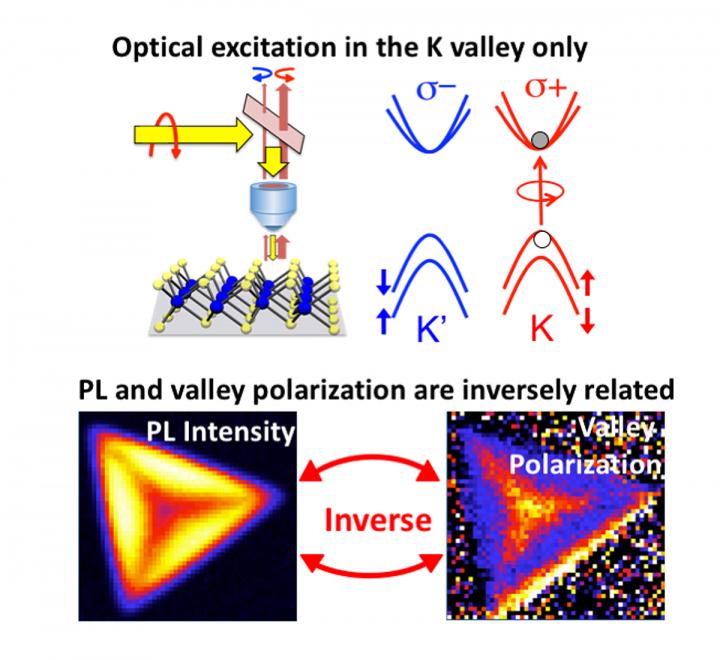NRL clarifies valley polarization for electronic and optoelectronic technologies

Upper Panel: schematic of optical excitation in the K valley of WS2 monolayers. Lower Panel: Photoluminescence (PL) intensity map of a triangular monolayer island of WS2 and the associated valley polarization map demonstrate the clear inverse relationship. Each map covers a 46 x 43 micron area. The regions exhibiting smallest PL intensity and lowest quality are found at the center of the flake and radiate outward toward the three corners. These regions correspond to the highest valley polarization. Credit: US Naval Research Laboratory
In this sense, a 'valley' refers to the region in an electronic band structure where both electrons and holes are localized, and 'valley polarization' refers to the ratio of valley populations — an important metric applied in valleytronics research.
“A high degree of valley polarization has been theoretically predicted in TMDs yet experimental values are often low and vary widely,” said Kathleen McCreary, Ph.D., lead author of the study. “It is extremely important to determine the origin of these variations in order to further our basic understanding of TMDs as well as advance the field of valleytronics.”
Many of today's technologies (i.e. solid state lighting, transistors in computer chips, and batteries in cell phones) rely simply on the charge of the electron and how it moves through the material. However, in certain materials such as the monolayer TMDs, electrons can be selectively placed into a chosen electronic valley using optical excitation.
“The development of TMD materials and hybrid 2D/3D heterostructures promises enhanced functionality relevant to future Department of Defense missions,” said Berend Jonker, Ph.D., principal investigator of the program. “These include ultra-low power electronics, non-volatile optical memory, and quantum computation applications in information processing and sensing.”
The growing fields of spintronics and valleytronics aim to use the spin or valley population, rather than only charge, to store information and perform logic operations. Progress in these developing fields has attracted the attention of industry leaders, and has already resulted in products such as magnetic random access memory that improve upon the existing charge-based technologies.
The team focused on TMD monolayers such as WS2 and WSe2, which have high optical responsivity, and found that samples exhibiting low photoluminescence (PL) intensity exhibited a high degree of valley polarization. These findings suggest a means to engineer valley polarization via controlled introduction of defects and nonradiative recombination sites
“Truly understanding the reason for sample-to-sample variation is the first step towards valleytronic control,” McCreary said. “In the near future, we may be able to accurately increase polarization by adding defect sites or reduce polarization by passivation of defects.”
Results of this research are reported in the August 2017 edition of the American Chemical Society's Nano, The research team is comprised of Dr. Kathleen McCreary, Dr. Aubrey Hanbicki, and Dr. Berend Jonker from the NRL Materials Science and Technology Division; Dr. Marc Currie from the NRL Optical Sciences Division; and Dr. Hsun-Jen Chuang who holds an American Society for Engineering Education (ASEE) fellowship at NRL.
Media Contact
All latest news from the category: Interdisciplinary Research
News and developments from the field of interdisciplinary research.
Among other topics, you can find stimulating reports and articles related to microsystems, emotions research, futures research and stratospheric research.
Newest articles

Bringing bio-inspired robots to life
Nebraska researcher Eric Markvicka gets NSF CAREER Award to pursue manufacture of novel materials for soft robotics and stretchable electronics. Engineers are increasingly eager to develop robots that mimic the…

Bella moths use poison to attract mates
Scientists are closer to finding out how. Pyrrolizidine alkaloids are as bitter and toxic as they are hard to pronounce. They’re produced by several different types of plants and are…

AI tool creates ‘synthetic’ images of cells
…for enhanced microscopy analysis. Observing individual cells through microscopes can reveal a range of important cell biological phenomena that frequently play a role in human diseases, but the process of…





















